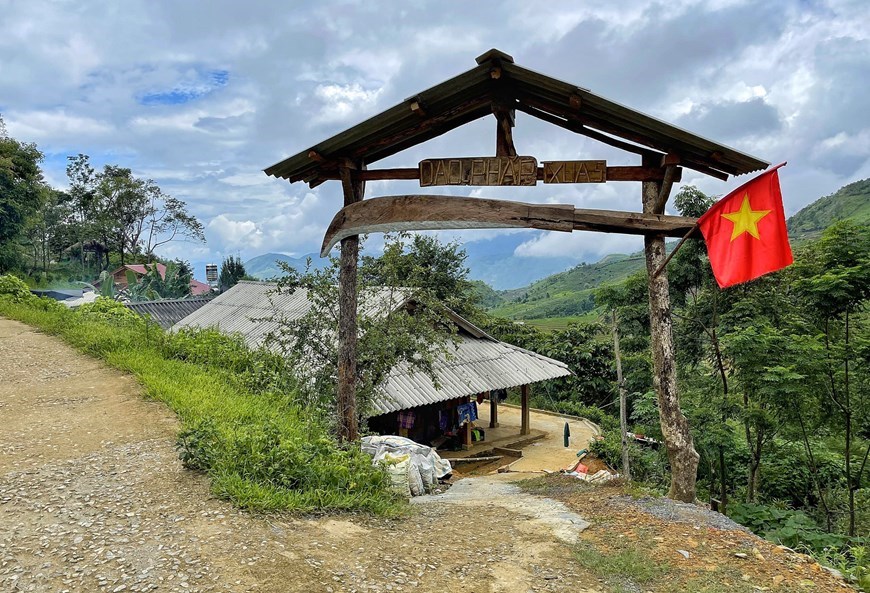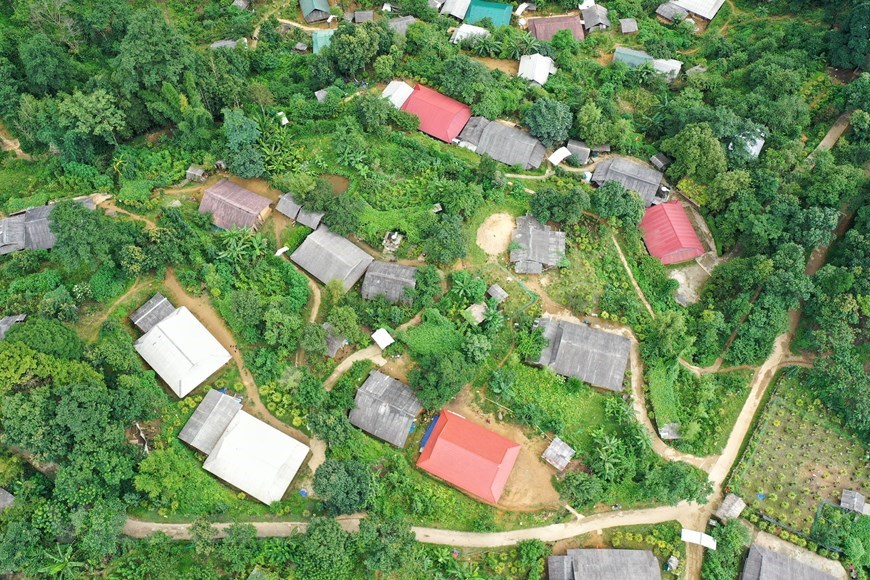-

About 30km from Lai Chau city – the capital of the northern mountainous province of Lai Chau, Sin Suoi Ho, a community-based tourism village in Phong Tho district, is located at an altitude of nearly 1,500 metres and boasts fresh air and cool weather all year round. In the Mong ethnic language, Sin Suoi Ho means ‘spring with gold’. Setting foot here at any time of the year, visitors can all enjoy picturesque landscapes and explore Mong people’s traditional customs that have been maintained for generations. Sin Suoi Ho is now a bright spot in developing community-based tourism, which has helped to substantially improve local living standards (Photo: VietnamPlus)
-

In the past, Sin Suoi Ho villagers relied solely on agriculture to earn their living. But after five to six years engaging in tourism, their mindset and awareness have changed considerably, and they have begun to make use of the local natural advantages. Sin Suoi Ho was recognised as a community-based tourism village in 2015. It is attractive to travellers thanks to not only its breathtaking scenery but also the rich culture of local residents. Ten of the over 100 households in the village are providing homestay services at present. Data show that Sin Suoi Ho welcomes about 100,000 visitors, both foreign and domestic ones, every year (Photo: VietnamPlus)
-

As Sin Suoi Ho embarked on community-based tourism later than many other localities, villagers were determined to make a difference. Given this, they decided to create unique gates so as to impress visitors right from the moment they set foot in the village. In the past, visitors coming to the village could only enjoy scenic landscapes and local food on day trips. Now, they can immerse in daily activities of local residents like farming and gardening. A local resident said tourists are warmly welcomed into local homes, and that they can stay here for weeks or months to experience farming, fruit picking, making dumplings and weaving cloth (Photo: VietnamPlus)
-

Though not all local families take part in community-based tourism, they still want to create their own imprint by making distinctive gates. Over the past years, authorities in the mountainous province of Lai Chau have been facilitating community-based tourism to develop the local economy and improve residents’ livelihoods. Diverse cultural identities of different ethnic groups hold great potential to develop tourism, including community-based tourism. Under Project No 316 on developing Lai Chau’s tourism for the 2016 – 2020 period, the province has been giving priority to stepping up key tourism products such as community-based tourism in Lai Chau city, Phong Tho district, and Tam Duong district (Photo: VietnamPlus)
-

With their creativity, residents in Sin Suoi Ho make use of the environmentally friendly materials available in their daily life to build special gates for their homes. Visiting the village, tourists will be surprised at the wooden and rammed earth houses bearing the typical architecture of the Mong ethnic minority. The unique highlight of these houses is a hand-lined stone fence surrounding them. The village is attractive to holidaymakers also thanks to its rich cultural and spiritual life that includes charming love songs and ‘khen’ (panpipe) sounds of Mong people. Besides, traditional crafts such as brocade embroidery and beeswax drawing on cloth are also maintained nowadays (Photo: VietnamPlus)
-

The recent resurgence of COVID-19 has discouraged people from travelling, which has made homestay facilities in Sin Suoi Ho deserted. Over the past years, Lai Chau has spent much from the local budget and encouraged local residents and private investors to boost community-based tourism. Between 2017 and 2019, about 350,000 visitors chose this northwestern mountainous province as their holiday destination. Tran Manh Hung, Deputy Director of the provincial Department of Culture, Sports and Tourism, said authorities have been working to disseminate the State and local administration’s policies on tourism development, improve people’s awareness of protecting the environment at tourist attractions, and organise tourism training classes for locals (Photo: VietnamPlus)
-

A gate with its horizontal bar in the shape of a hoe – a tool closely linked with agricultural activities of local residents. Mong people form one of the most populous ethnic minority groups in Vietnam, with a population of more than 1 million. They mainly reside in mountainous areas at an altitude of 1,000 metres and higher in the northern region, the western areas of the central provinces of Thanh Hoa and Nghe An, and others in the Central Highlands region. Among the 54 ethnic groups in the country, the Mong community is one of those that still maintain their traditional cultural identities in the current modern life (Photo: VietnamPlus)
-

A gate with its horizontal bar in the shape of an axe. Boasting special attractiveness to domestic and foreign tourists, Sin Suoi Ho village is blessed with magnificent landscapes and fresh air and cool climate all year round that are unforgettable to anyone who had a chance to set foot here. Data show that as of December 31, 2018, Lai Chau province was home to 19,320 Mong ethnic households with 106,090 people, accounting for 23.51 percent of the local population. They live in eight district-level localities of the province. Phong Tho district, where Sin Suoi Ho village is located in, had the second largest number of Mong people – more than 21,360 in 3,950 households (Photo: VietnamPlus)
-

Hang Thi Qua, a local tour guide, said these special gates and the culture of the Mong ethnic group are sources of pride of the local community-based tourism. Sin Suoi Ho was recognised as a community-based tourism village in 2015. According to village leader Vang A Chinh, there used to be a large number of drug addicts in Sin Suoi Ho. However, the number of addicts decreased gradually from 2005, and the village is now free of drug addicts thanks to the development of community-based tourism. From a poor village, local households have improved their incomes considerably by boosting tourism and selling local products such as orchids, cardamom, brocade, and rattan and bamboo items (Photo: VietnamPlus)
-

A gate with its horizontal bar in the shape of a machete. Sin Suoi Ho in Mong language means ‘spring with gold’, conjuring up the image of a peaceful small village, full of fruit trees with waterfalls and streams whispering all night and day. Its rich cultural and spiritual life is also a magnet to tourists. The most special are traditional festivals such as ‘Le mung lua moi’ (new rice celebration) and the ‘Gau Tao’ festival, the most important festival of the Mong people, held in early spring to express their gratitude to the Heaven and Earth and pray for good luck and happiness in the new year (Photo: VietnamPlus)
-

A girl in the traditional costume of the Mong women poses for a photo at a plough-shaped gate in Sin Suoi Ho. Women in the village still wear and weave traditional clothes made from linen nowadays. With rich and diverse natural and human resources, Sin Suoi Ho has proved to be a magnet for both domestic and foreign tourists. Among the more than 100 households in the village, ten are providing homestay services. Although it started to engage in tourism just a few years ago, this place has become a bright spot for community-based tourism in Lai Chau province thanks to local residents’ methodical, conscious and professional attitude (Photo: VietnamPlus)
-

The head of the village, Vang A Chinh, said residents in Sin Suoi Ho are very happy when visitors come to their village and experience the life and culture of the Mong people. Coming to the village, travellers will be surprised at the wooden and rammed earth houses bearing typical architectural features of the Mong ethnic minority. The unique highlight of these houses is a hand-lined stone fence surrounding them. This structure creates a solid house that is cool in summer and warm in winter. There remain dozens of traditional houses in Sin Suoi Ho at present, creating a charming landscape added to the surrounding magnificent scenery (Photo: VietnamPlus)
-

Tourism has become a considerable source of income helping to improve local living standards. Therefore, villagers are all unanimous in developing this green industry. With the support of the local administration, they have refurbished their houses to welcome visitors. At present, Sin Suoi Ho can accommodate more than 100 tourists per day with prices ranging from 70,000 – 100,000 VND per person a night. On average, it welcomes about 100,000 visitors, both domestic and foreign ones, each year. Each foreign guest spent an average of 1.6 days here while domestic visitors stay for 1.75 days. Apart from enjoying scenic landscapes and local food, travellers can immerse themselves in daily activities like farming, gardening, making dumplings and weaving cloth (Photo: VietnamPlus)
-

Local people raise pigs and chickens and grow vegetables by themselves to serve tourists. Since Sin Suoi Ho was recognised as a community-based tourism village, a market was formed there to serve tourism. Local seniors said previously there was no market in Sin Suoi Ho commune, where the village is located in. To buy goods, people had to go to the centre of Muong So commune (Phong Tho district) or San Thang market (Lai Chau city), about 20-30km away. Therefore, they decided to build a market that can serve as a place for locals to trade goods as well as attract more tourists. The market is held every Saturday, selling mainly farm produce and traditional costumes of ethnic minority groups (Photo: VietnamPlus)
-

Thanks to developing tourism and growing orchids, each local household can earn 30 – 50 million VND per year. The land used to grow opium in the past has flourished with more than thousands of orchid pots, peach trees, ‘tao meo’ (‘tao’ means apple, and ‘meo’ is a word of the Mong minority), 10 homestays and a restaurant. To better serve tourists, the village plans to make completely natural products in the traditional style of Mong people such as shampoo, soap, hand sanitiser, dishwashing liquid and bath medicine. An orchid garden owner said locals decorate their houses and expand cymbidium orchid gardens to welcome tourists, and that they are also supported by local authorities to make tourism more professional (Photo: VietnamPlus)
-

Residents in Sin Suoi Ho are all aware that the main attraction of their village is the preserved cultural identities of the Mong ethnic group. Mong people form one of the most populous ethnic minority groups in Vietnam, with a population of more than 1 million. Data show that as of December 31, 2018, Lai Chau province was home to 19,320 Mong ethnic households with 106,090 people, accounting for 23.51 percent of the local population. They live in eight district-level localities of the province. Phong Tho district, where Sin Suoi Ho village is located in, had the second largest number of Mong people – more than 21,360 in 3,950 households (Photo: VietnamPlus)
-

A birds-eye view of Sin Suoi Ho village. About 30km from Lai Chau city – the capital of the northern mountainous province of Lai Chau, the village is located at an altitude of nearly 1,500 metres and boasts fresh air and cool weather all year round. Sin Suoi Ho in Mong language means ‘spring with gold’, conjuring up the image of a peaceful small village, full of fruit trees with waterfalls and streams whispering all night and day. Setting foot here at any time of the year, visitors can all enjoy picturesque landscapes and explore Mong people’s traditional customs that have been maintained for generations (Photo: VietnamPlus)
Unique gates in Sin Suoi Ho – village of Mong ethnic people
Sin Suoi Ho is a village of the Mong ethnic group in Lai Chau province. Not only known as a village free of alcohol drinking, smoking, or gambling, it is also renowned for special hand-made gates that can be found nowhere else.



